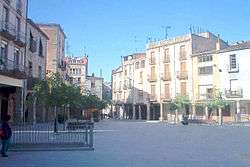Santa Coloma de Queralt
| Santa Coloma de Queralt | |
|---|---|
| Municipality | |
 | |
 Santa Coloma de Queralt Location in Catalonia | |
| Coordinates: 41°32′N 1°23′E / 41.533°N 1.383°E | |
| Country |
|
| Community |
|
| Province |
|
| Comarca |
|
| Government | |
| • Mayor | Magí Trullols Trull (2015)[1] |
| Area[2] | |
| • Total | 33.8 km2 (13.1 sq mi) |
| Elevation | 674 m (2,211 ft) |
| Population (2014)[1] | |
| • Total | 2,931 |
| • Density | 87/km2 (220/sq mi) |
| Demonym(s) | Colomís |
| Postal code | 43420 |
| Website |
www |

Santa Coloma de Queralt is a municipality in the comarca of the Conca de Barberà in Catalonia, Spain. It is situated in the north-east of the comarca about 60 km (37 mi) from the city of Tarragona. The town is linked to the rest of the comarca and to Igualada by the C-241 road.
History
In 976, Borrell II, Count of Barcelona, sold the castle of Queralt and the surrounding area to Viscount Guitart, and by 1018, castles had been built at Santa Coloma and other strategic locations. The Gurb-Queralt family established a barony and remained in control of the area for the next two centuries. By the end of the thirteenth century, Santa Coloma de Queralt was an important regional centre, serving as a market town that linked the local community and their need for commercial goods brought from other parts of the Mediterranean with the outside world.[3] These commercial activities attracted Jews, so that by the early fourteenth century, of the one hundred and fifty houses in the town, fifty were occupied by Jewish families.[4]
The Catalan Revolt in the mid-seventeenth century came about as a result of the continuing presence in Catalonia of Spanish troops during the Franco-Spanish War between the Kingdom of France and the Monarchy of Spain. Dalmau de Queralt, Count of Santa Coloma, who was the Spanish viceroy of Catalonia at the time, was assassinated by the rebels near the beginning of the revolt. After the war, the town returned to the control of the Queralt family.[5]
Tourism
Santa Coloma de Queralt is a historic town. Some of the main points of interest are the four medieval gateways thet formed part of the walls that used to surround the old town. There are also the remains of the Castles d'Aguiló and Queralt, and the Palace of the Counts of Queralt is an imposing edifice. There are two squares surrounded by porticoed buildings, the Plaça Major and the Plaça de l’Església. The Casa de la Villa now houses the town hall, and the Jewish neighbourhood has small twisting streets. The Gothic church of Santa Coloma was built in the 14th century. The Church of Santa Maria de Bell-lloc dates to the 13th and 14th century. It is built in Gothic style but with a Romanesque portal. It houses the alabaster sepulchre of the Counts of Queralt which dates from 1370.[6]
References
- 1 2 "Ajuntament de Santa Coloma de Queralt". Generalitat of Catalonia. Retrieved 2015-11-13.
- ↑ "El municipi en xifres: Santa Coloma de Queralt". Statistical Institute of Catalonia. Retrieved 2015-11-23.
- ↑ Milton, Gregory B. (2012). Market Power: Lordship, Society, and Economy in Medieval Catalonia (1276-1313). Palgrave Macmillan. pp. 11–12. ISBN 978-1-137-01275-3.
- ↑ Nirenberg, David (2015). Communities of Violence: Persecution of Minorities in the Middle Ages. Princeton University Press. p. 27. ISBN 978-1-4008-6623-6.
- ↑ Elliott, J.H. (1984). The Revolt of the Catalans. Cambridge University Press. p. 328. ISBN 978-0-521-27890-4.
- ↑ "Santa Coloma de Queralt". Espana: Spain's official tourism portal. Retrieved 11 October 2015.
- Panareda Clopés, Josep Maria; Rios Calvet, Jaume; Rabella Vives, Josep Maria (1989). Guia de Catalunya, Barcelona:Caixa de Catalunya. ISBN 84-87135-01-3 (Spanish). ISBN 84-87135-02-1 (Catalan).
External links
| Wikimedia Commons has media related to Santa Coloma de Queralt. |
- Official website (English) (Catalan)
- Generalitat of Catalonia - data
- Statistical Institute of Catalonia - the municipality in figures
 |
Llorac | Talavera | Argençola |  |
| Savallà del Comtat | |
Sant Martí de Tous | ||
| ||||
| | ||||
| Conesa | Les Piles | Bellprat |